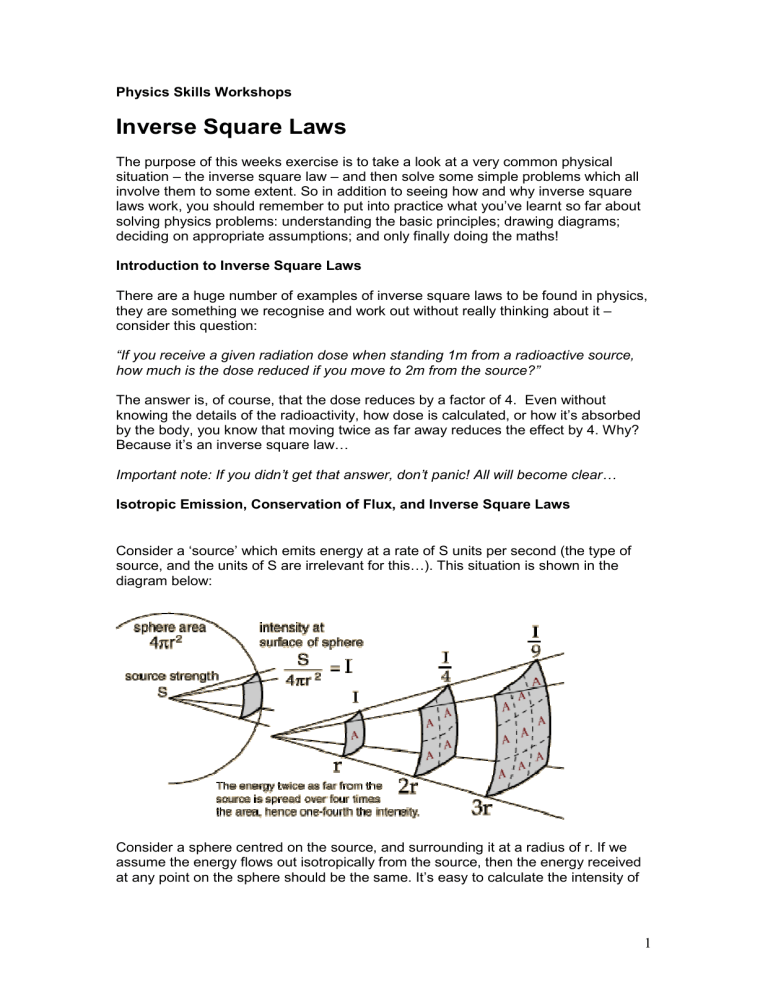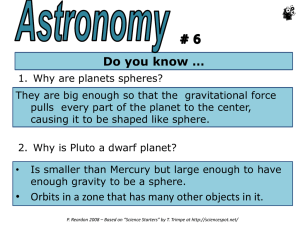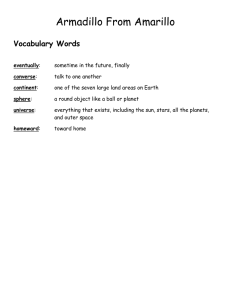Inverse Square Laws

id624922828 pdfMachine by Broadgun Software - a great PDF writer! - a great PDF creator! - http://www.pdfmachine.com http://www.broadgun.com
Physics Skills Workshops
Inverse Square Laws
The purpose of this weeks exercise is to take a look at a very common physical situation
–
the inverse square law
–
and then solve some simple problems which all involve them to some extent. So in addition to seeing how and why inverse square laws work, you should remember to put into practice what you
’ ve learnt so far about solving physics problems: understanding the basic principles; drawing diagrams; deciding on appropriate assumptions; and only finally doing the maths!
Introduction to Inverse Square Laws
There are a huge number of examples of inverse square laws to be found in physics, they are something we recognise and work out without really thinking about it
– consider this question:
“
If you receive a given radiation dose when standing 1m from a radioactive source, how much is the dose reduced if you move to 2m from the source?
”
The answer is, of course, that the dose reduces by a factor of 4. Even without knowing the details of the radioactivity, how dose is calculated, or how it
’ s absorbed by the body, you know that moving twice as far away reduces the effect by 4. Why?
Because it
’ s an inverse square law
…
Important note: If you didn
’ t get that answer, don
’ t panic! All will become clear
…
Isotropic Emission, Conservation of Flux, and Inverse Square Laws
Consider a
‘ source
’
which emits energy at a rate of S units per second (the type of source, and the units of S are irrelevant for this
…
). This situation is shown in the diagram below:
Consider a sphere centred on the source, and surrounding it at a radius of r. If we assume the energy flows out isotropically from the source, then the energy received at any point on the sphere should be the same. It
’ s easy to calculate the intensity of
1
the energy (energy/unit area) as it passes through the sphere, it
’ s just the total energy divided by the surface area of the sphere.
Now extend this idea to spheres at different radii - the surface area of each sphere increases as r
2
, so the intensity of the energy (per unit area) must reduce as 1/r
2
, and that
’ s it
–
the inverse square law.
So, in summary - Isotropic emission from a point generally results in an inverse square law because it mathematically describes the conservation of flux flowing out through concentric shells centred on that point.
That
‘ flux
’
can be many things:
Gravity
Light intensity
Electrostatic attraction/repulsion
Electromagnetic Radiation
Sound
Randomly emitted particles (so ionising radiation)
All these situations can be analysed in exactly the same (simple) way.
2
Example 1
–
Gravity in orbit
The International Space Station (ISS) orbits at an altitude of ~350km above the
Earth
’ s surface (Earth
’ s radius is 6378.2km). What fraction of the surface gravitational acceleration, g, is felt at this altitude?
So all this talk about feeling weightless in space is a bit misleading! Explain this apparent confusion.
3
Example 2
–
Force between charges
A charge of 8 x 10
-18
C is placed at (0,2) on the x,y-plane.
Calculate the force, and its direction, experienced by an electron placed at (4,5).
Where should the electron be moved to so that the force experienced is decreased by a factor of three?
What Examples 1 and 2 show us
…
These 2 examples show how simple scaling by an inverse square laws works well in situations where symmetry can be applied, and you are looking for a relative change.
However, when symmetry is not present, or when absolute levels are important, it can be necessary to quantify the flux passing through a specific area at a specific distance from the emitting source.
4
Solid angle calculations
The solid angle subtended by an area at a distance from a point emitter can be used to calculate the flux received by that area from the emitter.
The solid angle subtended by a surface S is defined as the surface area of a unit sphere covered by the surface's projection onto the sphere.
Formally, the solid angle for any shape can be calculated using this formula: where da is a small area of the shape, and n and r
2
define the unit vector and distance from the origin.
As you can calculate, the whole sky subtends a solid angle of 4
ð
steradians.
There is a much simpler way to calculate solid angles
–
called the spherical approximation. This assumes that the area A is all equidistant at a distance d from the reference point, and orthogonal to the unit vector from the origin. Under this approximation, we can state that the solid angle
A
d
2
.
If you can
’ t remember this formula, just remember the case for the whole sky, where d
A
A
2
and
4
.
Knowing the solid angle subtended by an area allows us to calculate what fraction of the emitted isotropic flux passes through that area.
F area
4
F emitted
Where
Ù
is the solid angle subtended by the area.
5
Example 3
–
Temperature of the planets
Estimating the temperature of the planets is a fairly simple calculation. Getting the right answer is considerably trickier
…
Of course, the biggest effect is the amount of energy each planet receives from the
Sun, so inverse square laws are fundamental to the calculation.
Step 1 First, calculate the solar energy flux on each planet, in W/m
2
, assuming the
Sun radiates energy at a rate of 3.8 x 10
26
W, and assuming the solar energy is radiated isotropically.
(hint: you need to make a solid angle calculation, with the area of 1m
2
at the distance of each planet)
Planet Mean distance from Sun
(AU
1
)
Solar flux
(W/m
2
)
Mercury
Venus
Earth
0.387
0.723
1
Saturn 9.54
Step 2 If each planet is in thermal equilibrium, it must be radiating away as much energy as it is receiving.
Use Stefan
’ s law (F =
ó
T
4
, where
ó
=5.67x10
-8
W/m
2
) combined with your values of F calculated above to calculate the expected temperatures of the planets (assuming no atmospheric effects) based on the following data.
Planet
Mars
Jupiter
1.524
5.203
Mercury
Venus
Earth
Mars
Mean distance from Sun (AU)
0.387
0.723
1
1.524
Temperature (K) Actual
Temperature
100-700
700
250-300
120-390
Jupiter
Saturn
5.203
9.54
110-150
95
Compare the calculated values and the actual values on a graph, and comment on the results you have obtained.
Why is this such a poor model
…
(i) the albedo of each planet (fraction of the incident solar radiation reflected) is very different
–
ie 0.06 for Mercury, 0.76 for Venus, 0.4 for Earth
1
One AU (Astronomical Unit) is the mean Earth-Sun distance, 1.495 x 10
11 m
6
(ii) the presence of an atmosphere dramatically changes the surface temperatures of a planet.
These
‘ sub-solar temperatures
’
you have calculated are essentially the equilibrium noontime temperatures on slowly rotating planets with no atmospheres.
Example 4
–
Sound pressure levels
The engines of a jet taking off emit a noise level of ~140 dB at 1m
–
which is enough to destroy your hearing very quickly. How far away do you need to stand to reduce the sound level to a more acceptable 85dB, which is about the safe limit for prolonged exposure?
Hint: Although this is a simple inverssquare law scaling again, this is a slightly more complex calculation, as you need to know that the dB scale is logarithmic (see box to the right)
First calculate the meaning of the change from 140 dB to 85dB, reexpressing this as a simple ratio of the sound energy levels.
Now calculate the appropriate distance you should move to.
You need to know how the ear perceives loudness.
First of all, the ear is very sensitive. The softest audible sound has a power of about 0.000000000001 watt/sq. meter and the threshold of pain is around 1 watt/sq. meter, giving a total range of 120dB. In the second place, our judgment of relative levels of loudness is somewhat logarithmic. If a sound has 10 times the power of a reference (10dB) we hear it as twice as loud. If we merely double the power (3dB), the difference will be just noticeable.
[The calculations for the dB relationships I just gave go like this; for a 10 to one relationship, the log of 10 is 1, and ten times 1 is 10. For the 2 to one relationship, the log of 2 is 0.3, and 10 times that is 3. Incidentally, if the ratio goes the other way, with the measured value less than the reference, we get a negative dB value, because the log of 1/10 is -1.]
7





